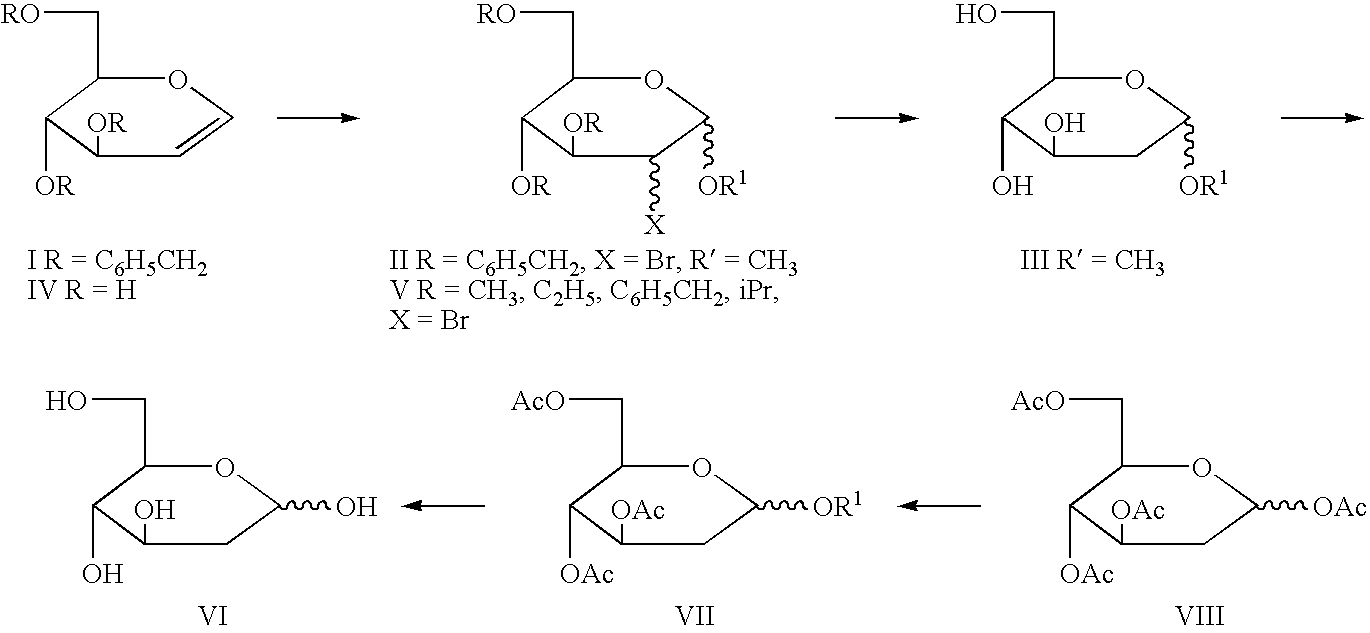Process for the synthesis of 2-deoxy-D-glucose
a 2-deoxy-d-glucose and synthesis technology, applied in the field of synthesis of 2deoxy-d-glucose, can solve the problems of poor yield, laborious, time-consuming and difficult, and the prior art of 2-deoxy-d-glucose preparation, and achieve good yield and good purity
- Summary
- Abstract
- Description
- Claims
- Application Information
AI Technical Summary
Benefits of technology
Problems solved by technology
Method used
Image
Examples
example 2
[0058] To a solution of D-glucal (64.6 g, 0.44 mmol) in methanol (325 ml) at 10.degree. C. was added N-bromosuccinimide (78.7 g, 0.44 mol) during 40 min. maintaining the temperature between 10-15.degree. C. during the addition. The reaction mixture was stirred at room temperature. After 5 hours solvent was evaporated to obtain a residue which was refluxed in ethyl acetate (100 ml). Ethyl acetate layer was discarded to leave a residue of methyl 2-bromo-2-deoxy-.alpha. / .beta.-D-gluco / mannopyranoside (105 g) as a syrup. [a].sub.D+36.degree. (c 1.0, MeOH). .sup.1H NMR (200 MHz, D.sub.2O): .delta. 3.47, 3.67 (2s, 3H, OCH.sub.3), 3.70-4.05 (m, 6h, H-23,4,5,6,6'), 4.48-5.13 (2s, 1H, H-1). The syrupy methyl 2-bromo-2-deoxy-.alpha. / .beta.-D-gluco- / mannopyranoside was dissolved in methanol (400 ml), a slurry of 80 g Raney nickel (a 50% slurry in methanol), Et.sub.3N (30 ml) and hydrogenated in a Parr apparatus at 120 psi. After 8-9 hours, the reaction mixture was filtered through a Celite fil...
example 3
[0063] A mixture of D-glucal (64.6 g), methanol (400 ml), N-bromosuccinimide (79 g) were stirred at 15.degree. C. for 6 h. The reaction mixture was hydrogenated in a Parr apparatus in presence of 60 g of Raney nickel catalyst (a 50% slurry in methanol) and triethylamine (62 ml). After 8-9 h, the reaction mixture was filtered on a Celite filter pad. The Celite pad was washed with methanol. The washings and filtrate were combined, concentrated to a thick heavy syrup, dissolve in chloroform (500 ml), pyridine (400 ml) and acetic anhydride (251 ml) was added while stirring, maintaining the temperature between 5-10.degree. C. After 12 hours, the reaction mixture was diluted with CHCl.sub.3 (500 ml) transferred to a separating funnel and organic phase was washed with water. The organic phase was separated, dried (Na.sub.2SO.sub.4) and concentrated to obtain methyl 2-deoxy-3,4,6-tri-O-acetyl-2 deoxy-.alpha. / .beta.-D-glucopyranoside as a syrup (163.43 g, 87%). [.alpha.].sub.D+65.0.degree. (...
example 4
[0064] A 500 ml round bottom flask equipped with magnetic stir bar was charged with a solution of D-glucal (323 g) in methanol (175 ml), cooled to 15.degree. C., N-bromosuccinimide (NIBS) (39.4 g) was added and stirred or 6 hours at 15.degree. C., The reaction mixture was concentrated to half the volume, cooled to 0.degree. C. and separated succinimide, was removed by filtration. To the filtrate was added a slurry of 30 g Raney nickel (a 50% slurry in Methanol) Et.sub.3N (32 ml) and hydrogenated in a Parr apparatus at 120 psi. After 7-8 hours, the reaction mixture was filtered through a Celite filter pad, and washed with MeOH. The washings and filtrate were combined and triturate with hexane to separate and remove by filtration insoluble triethylamine hydrobromide and succinimide. The filtrate was concentrated to a residue, dissolved in methanol and triturated with hexane to remove most of the triethylamine hydrobromide and succinimide. The filtrate was concentrated to obtain methyl...
PUM
| Property | Measurement | Unit |
|---|---|---|
| Fraction | aaaaa | aaaaa |
| Pressure | aaaaa | aaaaa |
| Angle | aaaaa | aaaaa |
Abstract
Description
Claims
Application Information
 Login to View More
Login to View More - R&D
- Intellectual Property
- Life Sciences
- Materials
- Tech Scout
- Unparalleled Data Quality
- Higher Quality Content
- 60% Fewer Hallucinations
Browse by: Latest US Patents, China's latest patents, Technical Efficacy Thesaurus, Application Domain, Technology Topic, Popular Technical Reports.
© 2025 PatSnap. All rights reserved.Legal|Privacy policy|Modern Slavery Act Transparency Statement|Sitemap|About US| Contact US: help@patsnap.com

